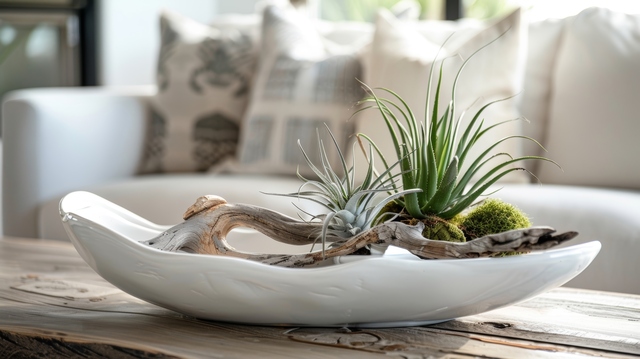
Tillandsia plants belong to the bromeliad family, which comprises 650 species of flowering plants.
They are often referred to as Air Plants.
Native to the Southern United States, Mexico, Central and South America, these rare plants have a fascinating way of survival.
They do not rely on soil for nutrients and water. Instead, they have specialized cells on the leaves called trichomes, which enable them to grow in unexpected locations, such as tree branches, telephone cables in the wild, etc.
They are a great choice as easy-to-grow indoor plants in Australia because they thrive wonderfully in any indoor environment and require the least maintenance.
In this guide, we will discuss Tillandsia growing tips, how to care for them, and where to place these air plants, regardless of your experience with gardening or indoor plants.
Why are Tillandsia plants referred to as "air plants"?
In their natural habitat, Tillandsia grow by attaching themselves to trees, rocks, and walls, absorbing moisture and nutrients from the atmosphere rather than the soil.
These plants are non-parasitic plants (Epiphytes) that take the support of other objects or plants. Because they grow without soil, they are a perfect addition to your indoors, straightforward to manage, and one of the best indoor plants in Australia.
How to Take Care of Tillandsia Plant Indoor?
Caring for air plants is quite simple. Here are some valuable Tillandsia growing tips to help keep them happy and healthy indoors.
1. Watering
Although they prefer dampness, air plants require regular watering to survive. It's vital to mist or soak them because they absorb water through their leaves rather than their roots. For the majority of species:
1. Give your Tillandsia plants a 20–30-minute soak in water once a week.
2. If your home isn't too humid, mist them two or three times a week between soaks.
3. To prevent rot, make sure they dry out completely in 3–4 hours after watering. Turn them upside down to let water drain off and keep moisture from getting trapped in the cracks.
The quality of the water is crucial. To avoid chlorine, use filtered water, rainwater, or left-out tap water. Steer clear of distilled or softened water since it contains too much salt and lacks vital nutrients that could damage your plant.
2. Light
Air plants thrive in bright, indirect light. Direct sunlight can burn their leaves, so place them in a well-lit room with lots of indirect light or next to a window that lets in filtered sunshine.
They are ideal for homes and offices because they also do well in full-spectrum fluorescent illumination.
3. Circulation of Air
As their name implies, air plants adore air! The key to their health is adequate air circulation. Avoid putting them in terrariums or other enclosed spaces without ventilation. Instead, go for open containers, wireframes, or driftwood mounts to showcase your plants in flair and let air circulate freely.
4. Temperature
The ideal temperature range for Tillandsia plants is 10 –32°C. To prevent temperature swings and plants from drying out, keep them away from drafts, heaters, and air conditioning vents.
5. Fertilizing
Even though air plants don't require many nutrients, you can still encourage growth and blooming by feeding them once a month with a fertilizer designed specifically for them or a bromeliad. Mix the fertilizer with water to dilute it, then soak or spritz your plants.
6. Flowering and Pups
Tillandsia blossoms can last from a few days to several months, depending on the species. They only bloom once in their lifetime.
Once it has flowered, the plant will yield 'pups' or baby plants. These pups can be gently removed when they reach between one-third and half the size of the parent plant, or they can be kept attached to the parent plant to form a clump.
Ensure the pups are getting enough water and light, and they will grow into mature plants.
Air Plant Dos and Don'ts
DO: Display these rare plants using creative spaces, such as seashells, driftwood, or hanging glass globes.
DON'T: Attach them to treated wood or copper since this may damage them.
DO: Make sure the container you use has enough airflow.
Don't: Keep your air plants in closed, excessively humid pots or direct sunlight.
How to Arrange Tillandsia
Indoor air plants come in various display options. Several well-liked concepts are:
Glass Globes: Glass globes that hang are ideal for showing off lone or tiny groups of plants. Just make sure there's adequate ventilation and stay out of the sun.
Mounted on Driftwood: This imaginative and organic display reflects their natural growth pattern.
Plants can be grouped in terrariums, but the doors should be kept open to let air flow through.
Wall Displays: Air plants can be fastened to wireframes or macramé for a contemporary, minimalist aesthetic.
Frequently Asked Questions
1. When is the right time to water my air plants?
Soak them for 20 to 30 minutes once a week and then mist them again two to three times, depending on the conditions.
2. Can soil be used to grow Tillandsia plants?
Not at all! It would help if you never planted air plants in the soil. Epiphytes draw their nutrients from the atmosphere rather than the soil.
3. What is the lifespan of air plants?
Several years can pass between Tillandsia, depending on the species and level of care given. Although a plant only blooms once, it will continue to grow by producing pups.
3. My air plant appears parched. How should I proceed?
If the leaves are curled or seem dry, they're probably not getting enough water. Soak it for an hour, dry it thoroughly, and then increase the misting frequency.
4. I have air plants; can I keep them in a terrarium?
Yes, but keep the terrarium open to ensure enough airflow. Your air plants may perish in enclosed terrariums because of the moisture they retain.
5. Are air plants able to live outside?
Yes, warm, humid climates. Just be aware of sudden weather swings and frost.
Growing a Tillandsia plant indoors is a straightforward approach to incorporating nature into your house.
These adaptable plants bring beauty to any area. They have the unusual capacity to flourish without soil and require little maintenance.
Air plants will add a touch of elegance to your interior garden, whether grouped in a terrarium, suspended in glass globes, or mounted on driftwood.
If you're an avid gardener or want to beautify your home and garden with greenery, visit PlantArk's blog to learn more about plant care.
PlantArk is an online plant marketplace in Australia where gardeners may sell and buy plants online.
Frequently check PlantArk's online plant store to check if your favourite plants are available.
Happy Gardening!


